new posts in all blogs
Viewing: Blog Posts Tagged with: Latino childrens books, Most Recent at Top [Help]
Results 1 - 16 of 16
How to use this Page
You are viewing the most recent posts tagged with the words: Latino childrens books in the JacketFlap blog reader. What is a tag? Think of a tag as a keyword or category label. Tags can both help you find posts on JacketFlap.com as well as provide an easy way for you to "remember" and classify posts for later recall. Try adding a tag yourself by clicking "Add a tag" below a post's header. Scroll down through the list of Recent Posts in the left column and click on a post title that sounds interesting. You can view all posts from a specific blog by clicking the Blog name in the right column, or you can click a 'More Posts from this Blog' link in any individual post.

By:
Betsy Bird,
on 10/18/2016
Blog:
A Fuse #8 Production
(
Login to Add to MyJacketFlap)
JacketFlap tags:
international children's books,
Juana Medina,
Best Books of 2016,
2016 reviews,
Reviews 2016,
2016 early chapter books,
Reviews,
Best Books,
Candlewick,
Latino children's books,
early chapter books,
Add a tag
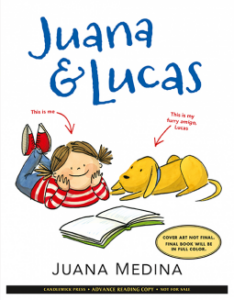 Juana and Lucas
Juana and Lucas
By Juana Medina
Candlewick Press
$14.99
ISBN: 978-1-7636-7208-9
Ages 6-9
On shelves now
Windows. Mirrors. Mirrors. Windows. Windowy mirrors. Mirrory windows. Windows. Mirrors. Sliding doors! Mirrors. Windows.
In the world of 21st century children’s literature, diversity should be the name of the game. We want books for our children that reflect the worlds they know and the worlds they have yet to greet. We want them to see themselves in their books (mirrors), see others unlike themselves (windows), and have a way to get from one place to another (sliding doors). To accomplish this, all you have to do is publish a whole bunch of books about kids of different races, religions, abilities, persuasions, you name it. Great strides have been made over the last few years in the general consciousness of the publishing industry (the publishers, the librarians, the teachers, and even the parents) even as teeny tiny, itty bitty, itsy bitsy tiptoes have been made in terms of what actually is getting published. Much of the credit for spearheading efforts to bring to light more and more books for all children can be given to the We Need Diverse Books movement. That said, our children’s rooms are still filled with monumental gaps. Contemporary Jewish characters are rare. Muslim characters rarer still. And don’t even TALK to me about the state of kids in wheelchairs these days. Interestingly enough, the area where diversity has increased the most is in early chapter books. Whether it’s Anna Hibiscus, Lola Levine, Alvin Ho, or any of the other new and interesting characters out there, there is comfort to be found in those books that transition children from easy readers to full-blown novels. Into this world comes Juana Medina and her semi-autobiographical series Juana & Lucas. Short chapters meet universal headaches (with details only available in Bogota, Colombia) ultimately combining to bring us a gal who will strike you as both remarkably familiar and bracingly original.
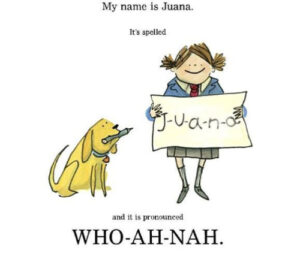 You might think that Juana has it pretty good, and for the most part you’d be right. She lives in Bogota, Colombia “the city that’s closest to my heart” with her Mami. She has a good furry best friend (her dog, Lucas) and a good not-so-furry best friend (Juli). And hey, it’s the first day of school! Cool, right? Only nothing goes the way Juana planned. The whole unfortunate day is capped off when one of her teachers informs the class that they will be learning “the English” this year. Could anything be more unfair? Yet as Juana searches for sympathy amongst her friends and relatives, she realizes that everyone seems to think that learning English is a good thing. Are they crazy? It isn’t until an opportunity comes up to visit somewhere fantastic, far away, and English speaking that she finally takes what everyone has told her to heart. In a big way.
You might think that Juana has it pretty good, and for the most part you’d be right. She lives in Bogota, Colombia “the city that’s closest to my heart” with her Mami. She has a good furry best friend (her dog, Lucas) and a good not-so-furry best friend (Juli). And hey, it’s the first day of school! Cool, right? Only nothing goes the way Juana planned. The whole unfortunate day is capped off when one of her teachers informs the class that they will be learning “the English” this year. Could anything be more unfair? Yet as Juana searches for sympathy amongst her friends and relatives, she realizes that everyone seems to think that learning English is a good thing. Are they crazy? It isn’t until an opportunity comes up to visit somewhere fantastic, far away, and English speaking that she finally takes what everyone has told her to heart. In a big way.
I love, first and foremost, the fact that the emotional crux of this book is fixated on Juana’s detestation of learning “the English”. Now already I’ve heard some commenters online complain that Juana’s problem isn’t something that English-speaking children will identify with. Bull. Any child that has ever learned to read will know where Juana is coming from. What English speaker would fail to sympathize when she asks, “Why are read and read written the same way but sound different? How can I know when people are talking about eyes or ice when they sound about the same? And what about left hand and left the room? So many words, so little sense”? Some kids reading this book may have experience learning another language too. For them, Juana’s complaints will ring true and clear. That’s a key aspect of her personality. She’s sympathetic, even when she’s whining.
For all that we’ve seen books like Juana’s, Lola Levine, Zapato Power, Pedro, First Grade Hero, Sophia Martinez, and a handful of others, interestingly this increase in Latino early chapter book is relatively recent. For a long time it was Zapato Power or nothing. The change is great, but it’s significant to note that all the books I’ve mentioned here are set in the United States. American books set in South American countries where the kids just live their daily lives and don’t have to deal with civil wars or invasions or coyotes or drug runners are difficult to find. What makes Juana and Lucas so unique is that it’s about a child living her life, having the kinds of problems that Ramona or Ruby Lu or Dyamonde Daniel could relate to. And like Anna Hibiscus or The Great Cake Mystery I love books for younger children that go through daily life in other present day countries. Windows indeed.
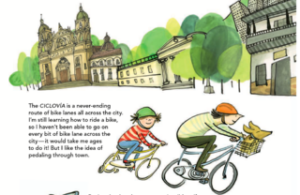 Early chapter books are interesting because publishers see them as far more series-driven than their writers might. An author can crank out title after title after title to feed the needs of their young readers, always assuming the demand is there, and they can do it easier with books under 100 pages than above. Juana could fit the bill in this regard. Her personality is likable, for starters. She’s not rude like Junie B. Jones or willfully headstrong in the same way as Ramona, but she does screw up. She does complain wildly. There are aspects of her personality you can identify with right from the start. I’d be pleased to see more of her in the future, and young readers will undoubtedly feel the same way. Plus, she has one particular feature that puts her heads and tails above a lot of the competition: She’s in color.
Early chapter books are interesting because publishers see them as far more series-driven than their writers might. An author can crank out title after title after title to feed the needs of their young readers, always assuming the demand is there, and they can do it easier with books under 100 pages than above. Juana could fit the bill in this regard. Her personality is likable, for starters. She’s not rude like Junie B. Jones or willfully headstrong in the same way as Ramona, but she does screw up. She does complain wildly. There are aspects of her personality you can identify with right from the start. I’d be pleased to see more of her in the future, and young readers will undoubtedly feel the same way. Plus, she has one particular feature that puts her heads and tails above a lot of the competition: She’s in color.
Created in ink and watercolor, Medina illustrates as well as writes her books. This art actually puts the book in a coveted place few titles can brag. You might ask if there’s a middle point between easy books and, say, Magic Tree House titles. I’d say this book was it. Containing a multitude of full-color pictures and spreads, it offers kids the comfort of picture books with the sensibility and sophistication of chapter book literature. And since she’s already got the art in place, why not work in some snazzy typography as well? Medina will often integrate individual words into the art. They swoop and soar around the characters, increasing and decreasing in size, according to their wont. Periodically a character will be pulled out and surrounded by fun little descriptor tidbits about their personage in a tiny font. Other times sentences move to imitate what their words say, like when Juana discusses how Escanilberto can kick the ball, “hard enough to send it across the field.” That sentence moves from his foot to a point just above his opponent’s head, the ball just out of reach. I like to think this radical wordplay plays into the early reader’s enjoyment of the book. It’s a lot more fun to read a chapter book when you have no idea what the words are going to pull on you next.
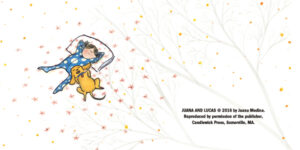 The writing is good, though the conclusion struck me as a bit rushed. Admittedly the solution to Juana’s problems is tied up pretty quickly. She won’t learn, she won’t learn, she won’t learn. She gets to have a prize? She studies and studies and studies. So rather than have her come to an understanding of English’s use on her own, an outside force (in this case, the promise of seeing Astroman) is the true impetus to her change. Sure, at the very end of the book she suddenly hits on the importance of learning other languages and visiting other places around the globe but it’s a bit after the fact. Not a big problem in the book, of course, but it would have been cool to have Juana come to this realization without outside influences.
The writing is good, though the conclusion struck me as a bit rushed. Admittedly the solution to Juana’s problems is tied up pretty quickly. She won’t learn, she won’t learn, she won’t learn. She gets to have a prize? She studies and studies and studies. So rather than have her come to an understanding of English’s use on her own, an outside force (in this case, the promise of seeing Astroman) is the true impetus to her change. Sure, at the very end of the book she suddenly hits on the importance of learning other languages and visiting other places around the globe but it’s a bit after the fact. Not a big problem in the book, of course, but it would have been cool to have Juana come to this realization without outside influences.
As nutty as it sounds, Juana and Lucas is a bit short on the “Lucas” side of that equation. Juana’s the true star of the show here, relegating man’s best friend to the sidelines. Fortunately, I have faith in this series. I have faith that it will return for future sequels and that when those sequels arrive they’ll have a storyline for Lucas to carry on his own. With Juana nearby, of course. After all, she belongs to the pantheon of strong female early chapter characters out there, ready to teach kids about life in contemporary Colombia even as she navigates her own trials and successes. And it’s funny. Did I mention it’s funny? You probably got that from context, but it bears saying. “Juana and Lucas” is the kind of book I’d like to see a lot more of. Let’s hope Ms. Medina is ready to spearhead a small revolution of early chapter book international diversity of her very own.
On shelves now.
Like This? Then Try:

So we need diverse books, which at this point in the proceedings shouldn’t really be news to much of anyone. You know it. I know it. But ascertaining progress can be tricky in these matters. Anyone who works in publishing knows that it takes years and years for books to reach publication. Read through any copy of PW Children’s Bookshelf and you’ll have the enormously satisfying experience of noting all the diverse authors being announced there. Yet it will take some time before their books hit our shelves. What is there for the kiddos in the interim?
To answer this, I turned to one of the smaller subsets of children’s literature: books starring Latino characters. In the past this has been a lamentable experience. Most of what was out there got a Pura Belpre nod and that was it. There’s a reason the Pura Belpre used to be every other year, folks. But 2015 has been different. We’re seeing the number of titles going up up up and I like what I see. Please note however that there is still a lot of work to be done. In the grand scheme of what is being published (and when we compare the number of books here to the number of Hispanic Americans residing in the States) there is work to be done.
With that in mind, here are the 2015 books starring Latino and Latino-American characters. I know that there are titles that I have missed. Feel free to chime in with them in the comments.
Picture Books
Drum Dream Girl by Margarita Engle. Illustrated by Rafael Lopez
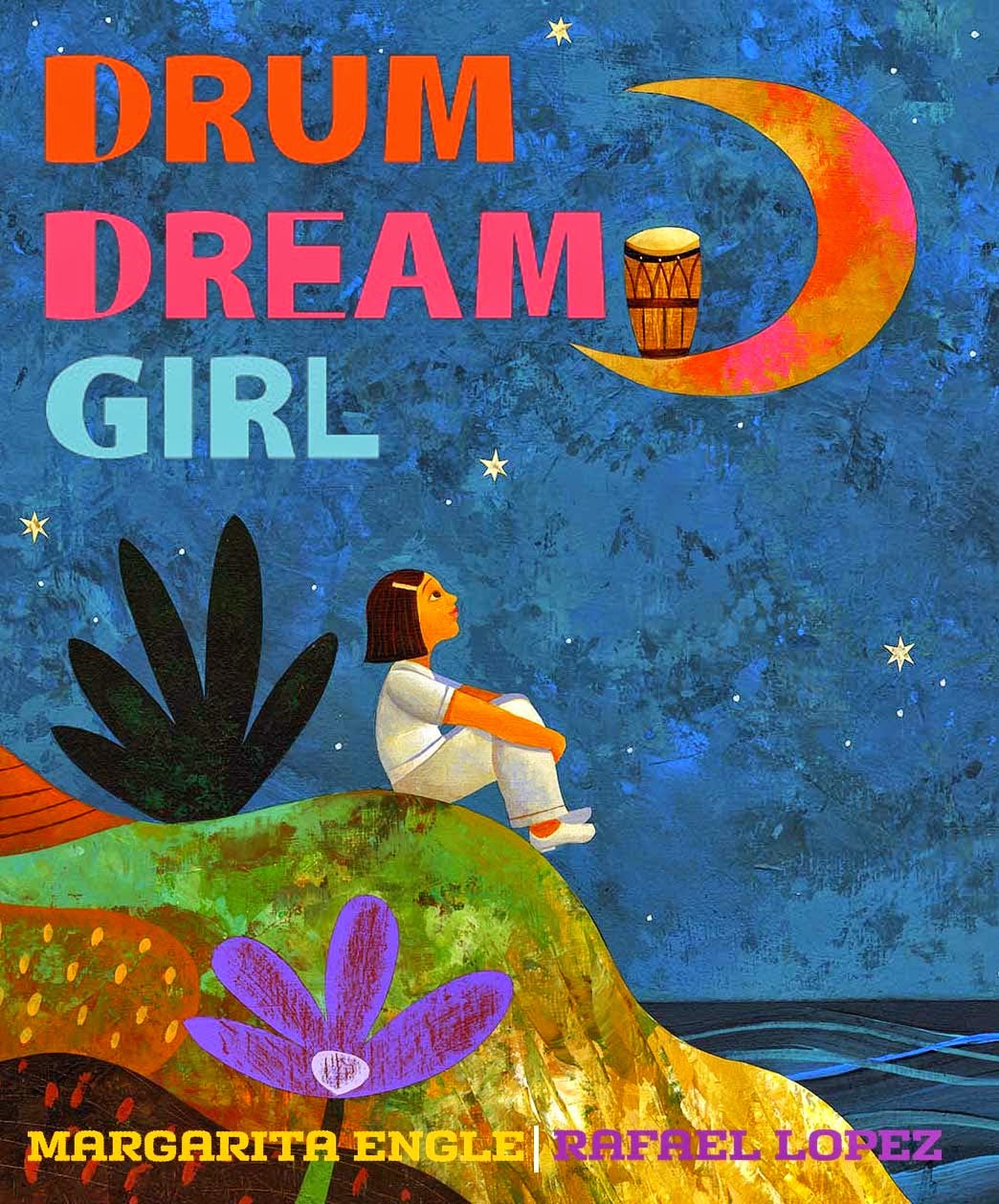
Still kicking myself that I didn’t include this in my last Caldecott prediction round-up. There’s time enough. By the way, if you want to play the how-many-books-does-Margarita-Engle-have-out-in-2015 game, now’s the time to start counting. Read the Seven Impossible Things interview with the creators here.
Papa Gave Me a Stick by Janice Levy. Illustrated by Simone Shin
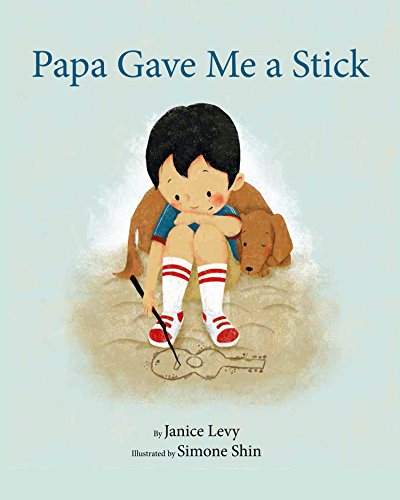
A very simple story about a boy who wants a guitar and the folktale-esque way in which he acquires one. In a lot of ways it had many similarities to the far more serious . . .
Finding the Music / En Pos de la Musica by Jennifer Torres. Illustrated by Renato Alarcao

Again we have a kid obsessed with getting a guitar (and mariachis too, come to think of it). However, this book was far more realistic and for an older readership in general.
Hens for Friends by Sandy De Lisle. Illustrated by Amelia Hansen

In 2015 hens are hot. SLJ recently highlighted three of them, but I’ve seen far far more than that so far. Case in point this sweet little tale. It’s a story about keeping backyard chickens and would pair nicely with fellow 2015 release Millie’s Chickens by Brenda Williams.
Little Chanclas by Jose Lozano
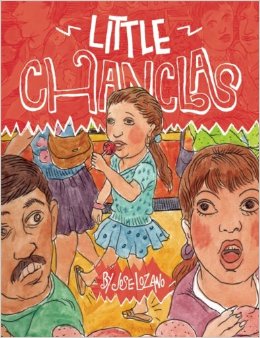
If you want to talk about the publisher who’s been putting out Latino children’s literature with the greatest consistency, you’d be amiss in not pointing to Cinco Punto Press. Each year they’ve a plethora of titles. If the company’s name sounds familiar that may be because of their recent runaway YA hit Gabi, A Girl in Pieces. This year they’ve at least two titles that caught my eye. This and . . .
My Tata’s Remedies / Los remedios de mi tata by Roni Capin Rivera-Ashford. Illustrated by Antonio Castro L.

. . . this. An intergenerational tale, not too different from . . .
Mango, Abuela and Me by Meg Medina. Illustrated by Angela Dominguez
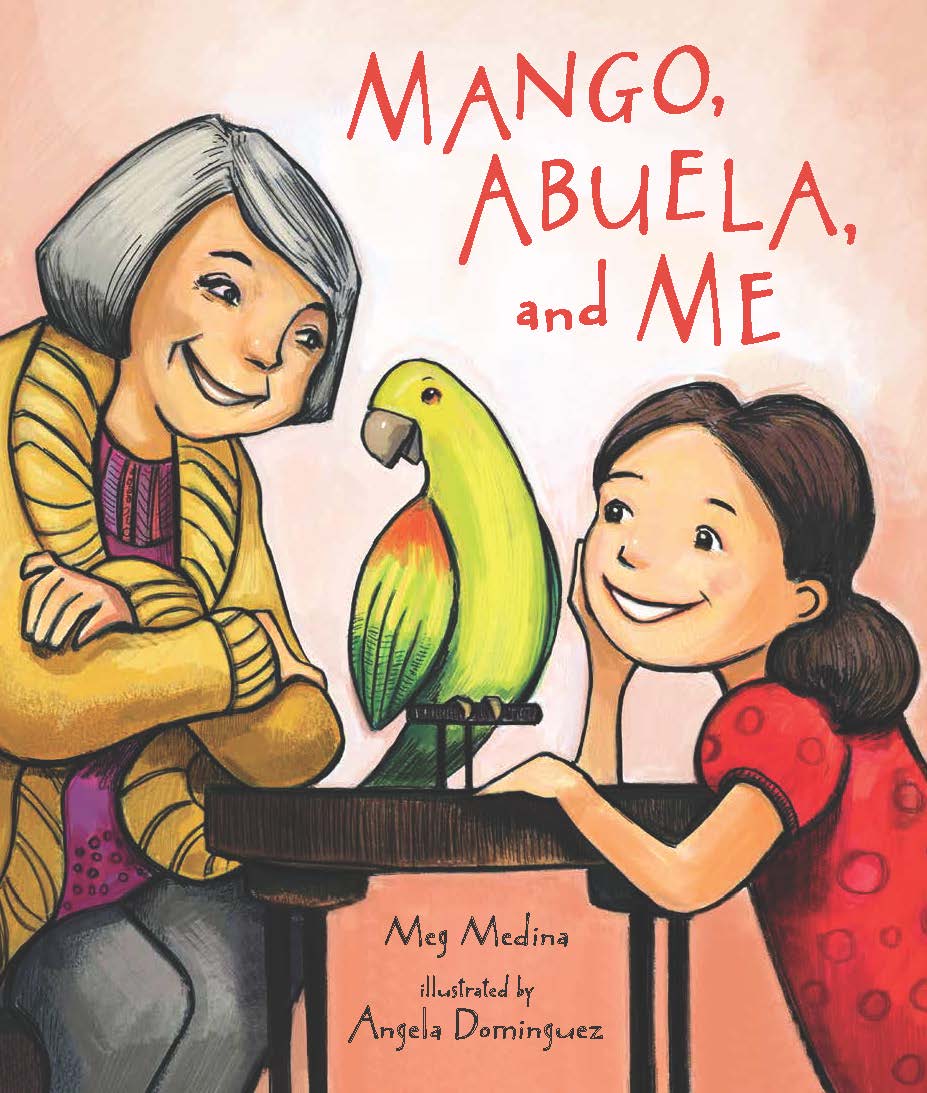
I know at least two women who hiss and growl every time they see a picture book where the grandmother is portrayed in the stereotypical old lady manner. So I love how the abuela here is a very realistically aged woman. The story of how she and her granddaughter overcome their language barriers makes it one of the lovelier books this year.
Salsa: Una Poema Para Cocinar / A Cooking Poem by Jorge Argueta. Illustrated by Duncan Tonatiuh

I’m fairly certain there are more bilingual picture books out in 2015 that I’m simply blanking on. With Mr. Tonatiuh’s rise in fortunes thanks to his ALA Youth Media Award wins for Separate Is Never Equal, I expect we’ll be seeing a lot more of this fella in the future.
The Sock Thief by Ana Crespo. Illustrated by Nana Gonzalez

Note the boy character. I was happy to see a pretty even split between the boys and the girls in the picture book sphere. Unfortunately that equality takes a bit of a nose dive as we go up in reading levels.
Early Chapter Books
In many ways, this is the area that has seen the most improvement. When it comes to Latino characters in early chapter books, you pretty much have Zapato Power or nothing. This year we’re seeing three new series and one new standalone title. Unfortunately, the gender tilts a little too far in one direction.
Sofia Martinez: My Family Adventure by Jacqueline Jules. Illustrated by Kim Smith
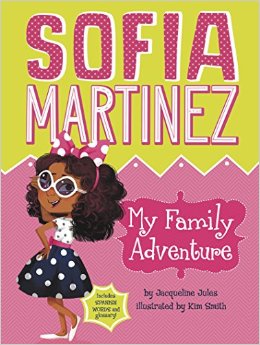
Look at the attitude on that girl! Smith’s art goes a long way towards selling Sofia as a character. You look at this book jacket and you want to know more about her. Fortunately, you’ll have your chance. Future Sofia titles are being produced left, right, and central.
Emma Is On the Air: Big News by Ida Siegal. Illustrated by Karla Pena

This one’s a little different since author Ida Siegal is (at least according to Wikipedia) “an American television journalist news reporter who has been an on-air reporter for NBC New York since January 2003″ (you can tell she’s a kind of celebrity because illustrator Karla Pena’s name is nowhere to be found on the cover, at least in this edition). No complaints here, mind you. The more the merrier.
Lola Levine is Not Mean! by Monica Brown
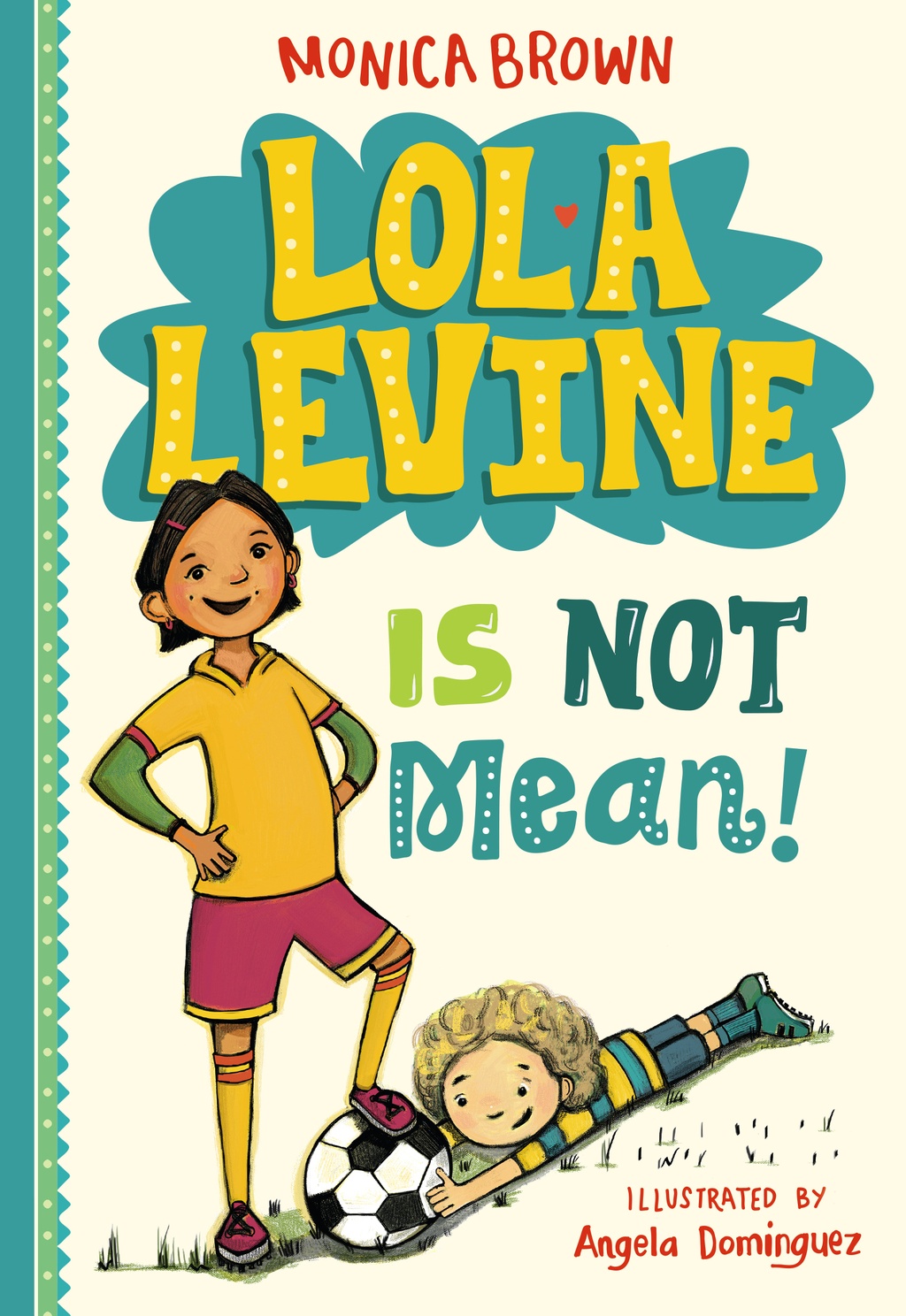
Like Drum Dream Girl, which features a Chinese-African-Cuban heroine, Lola Levine is one of the finer heroines sporting a dual heritage. Peruvian/Jewish, I like this cover particularly since it shows Lola doing what she does best while her brother lies at her side.
The Best Friend Battle by Lindsay Eyre
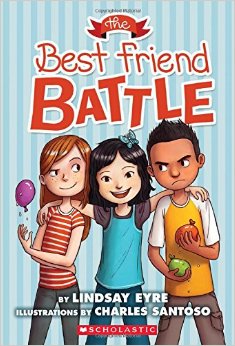
If you noticed that all the prior books were sporting girls and not boys, that is true. We certainly need more boys in all areas but particularly in the early chapter book and middle grade novel areas. In this case, Georgie Diaz isn’t the focus of the book. No, the heroine is the girl on the far left, and she’s just trying to hold onto her best friend in spite of the (very platonic) friendship overtures Georgie’s engaged in.
Middle Grade Novels
Canned and Crushed by Bibi Belford

When boys do make covers we don’t always see their faces. Example B:
Echo by Pam Munoz Ryan

There are, of course, exceptions to the rules. This gorgeous cover for one . . .
The Amazing Adventures of Broccoli Boy by Frank Cottrell Boyce
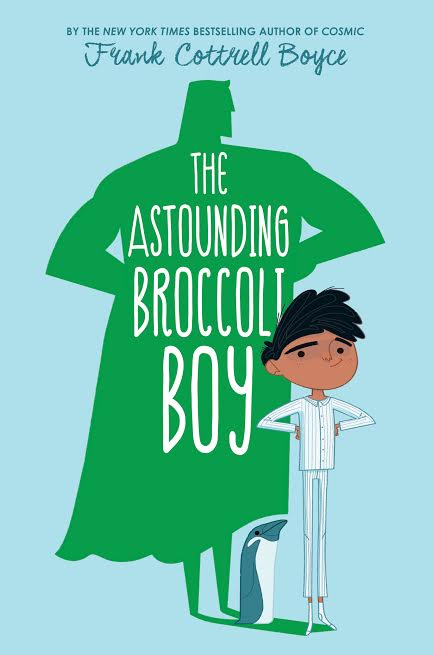
Considering that the boy lives in England, I’m still gonna count it. It’s such a great book, after all.
Look Both Ways in the Barrio Blanco by Judy Rose

Quite possibly one of the best book jackets of the year.
Unusual Chickens for the Exceptional Poultry Farmer by Kelly Jones. Illustrated by Katie Kath
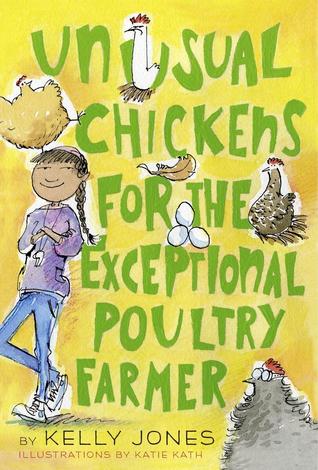
See? Chickens! They’re everywhere!
Zack Delacruz: Me and My Big Mouth by Jeff Anderson
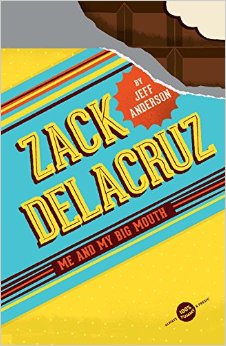
Graphic Novels
Roller Girl by Victoria Jamieson

A good example of casual diversity. Astrid’s ethnicity is never called into question or even becomes a point of the book.
Biographies
Growing Up Pedro: How the Martinez Brothers Made It from the Dominican Republic All the Way to the Major Leagues by Matt Tavares
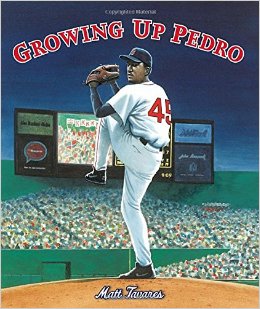
Last year I had a devil of a time finding good picture book sports bios. They’re out there, folks and they vary in terms of content. This is one of the winners.
Island Treasures: Growing Up in Cuba by Alma Flor Ada
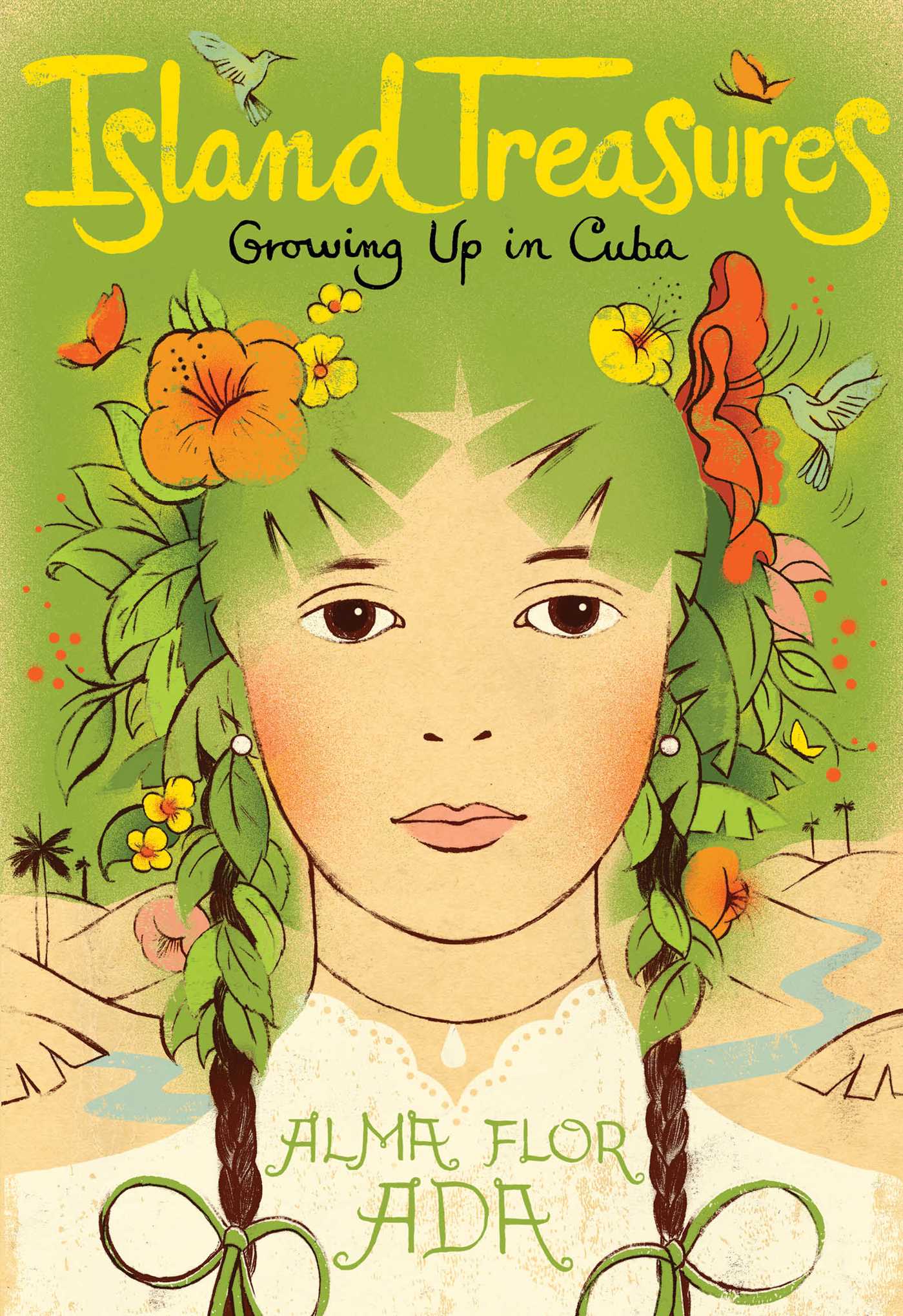
Brown Girl Dreaming set loose the publisher wheels. I have no doubt Ms. Engle was working on this for years. The time is now perfect to release it. It is, I do believe, a middle grade memoir. Oh, rarest of beasts.
The Sky Painter: Louis Fuertes, Bird Artist by Margarita Engle. Illustrated by Aliona Bereghici
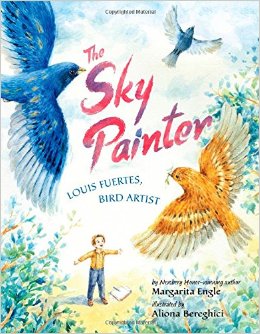
By my count this is Ms. Engle’s third book out this year. There may be more in the works.
So what have I missed? We’ve an entire season on the horizon. Surely this is just a drop in the ocean, yes?

My husband’s best friend returned to us the other day from his vacation in South America bearing gifts. Amongst them was a t-shirt for my daughter featuring this cartoon tyke:

Know her? If you’re American the answer is probably no. But if you were Argentinian you’d instantly recognize her as Mafalda. She was Argentina’s answer to Charlie Brown from 1964 to 1973 and is basically recognized all over the world . . . with the exception of the U.S.
She gets me to thining. When we talk about the #WeNeedDiverseBooks campaign we need to look beyond standard fictional fare. We need to look at easy books, early chapter books, nonfiction, poetry, fairytales and folk tales, and, yes, graphic novels. And of all the comics published specifically for the young reader market in 2014 that were marketed to libraries, only one had anything even faintly resembling Latino content (Lowriders in Space by Cathy Camper, ill. Raul the Third).
None of this is to say that if Mafalda were translated for the American market she wouldn’t appear with an adult publisher like Dark Horse. Like the aforementioned Charlie Brown she had some pretty advanced jokes. No, for me Mafalda is just proof positive that when we’re looking for diverse characters, we shouldn’t forget about the ones published internationally. Our scope is so limited here in the States. If there is any unexpected offshoot of the #WeNeedDiverseBooks campaign, I hope it’s that we are able as consumers and publishers to expand our focus and look into those characters and creations from countries outside of our own. Mafalda is just the tip of the iceberg.
A couple of her comic strips to amuse you today:



And a fun piece on her unexpected origins.


By:
Betsy Bird,
on 12/2/2014
Blog:
A Fuse #8 Production
(
Login to Add to MyJacketFlap)
JacketFlap tags:
Children's Literary Salon,
All-of-a-Kind Family,
Muslim Americans,
podcasts,
Native Americans,
Richard Scarry,
Barbie,
Jacqueline Woodson,
NBC,
Politics and Prose,
Frances Hardinge,
Latino children's books,
Fusenews,
celebrity children's authors (may they rot),
Add a tag
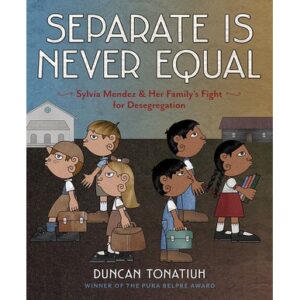 There was a time, oh children of mine, when the ALA Media Awards would be announced and the morning after the announcement the winners of the Caldecott and Newbery Awards would be whisked away to New York City to speak on NBC. Then Snooki came and ruined everything (this is the abbreviated version, but it’s not too far off). So we’re none too pleased with NBC these days. Al Roker’s Book Club aside (and it looks like it hasn’t updated since Halloween) there’s not a lot going on at that channel. But then they go and post the Latinas for Latino Lit: “Remarkable” Children’s Books of 2014 piece (selected by Viviana Hurtado and Monica Olivera) and much is forgiven. Just one question about the list, though . . . no Viva Frida?
There was a time, oh children of mine, when the ALA Media Awards would be announced and the morning after the announcement the winners of the Caldecott and Newbery Awards would be whisked away to New York City to speak on NBC. Then Snooki came and ruined everything (this is the abbreviated version, but it’s not too far off). So we’re none too pleased with NBC these days. Al Roker’s Book Club aside (and it looks like it hasn’t updated since Halloween) there’s not a lot going on at that channel. But then they go and post the Latinas for Latino Lit: “Remarkable” Children’s Books of 2014 piece (selected by Viviana Hurtado and Monica Olivera) and much is forgiven. Just one question about the list, though . . . no Viva Frida?
- What is the state of children’s nonfiction in the UK today? For our answer we turn to my favorite British blog Playing By the Book which reveals revelation after revelation in the piece Do We Care About Children’s Non-Fiction? Apparently informational books don’t get reviewed all that often in the U.K. Do the British value nonfiction then? Definitely fascinating reading.
- “I mean, seriously, can you think of one popular show/movie that actually tries to portray Muslims accurately instead of as a confining stereotype?” The excellent Summer writes on her blog Miss Fictional’s World of YA the piece I Am Not Oppressed. In particular she’s not particularly pleased with how Muslim women are depicted on the bulk of our book jackets (to say nothing of the content inside).
- Hm. So Entertainment Weekly just released a list of 50 Books Every Kid Should Read. Interesting, yes? And the choices are fascinating. They made an effort to do the classics and then work in some contemporary titles. What they chose is telling. Little Willow presents the list and leads the discussion as well.
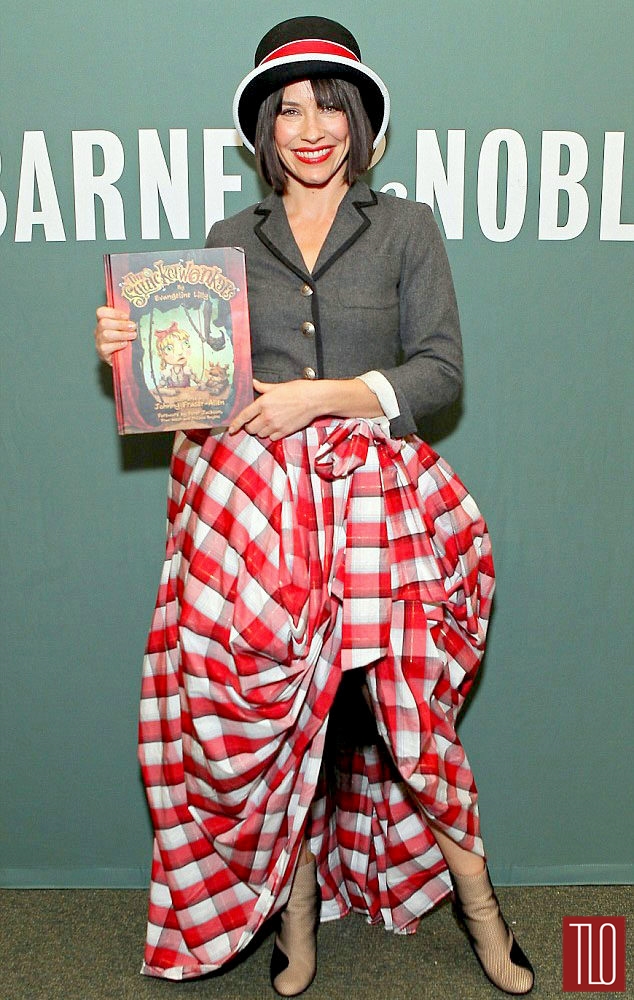
Okaaaaay. So that’s what Evangeline Lilly wore to her children’s book signing at Barnes & Noble. Clearly this is the outfit children’s authors should all be wearing now. Those of you hankering to wear your picnic blanket as a skirt now finally have an excuse to do so. Thanks to Jules for the link.
- And now, the best news of the week. My love for the author Frances Hardinge knows no bounds. Honestly, I do believe that The Lost Conspiracy may be my favorite children’s book published in the last 10 years. It’s a serious contender in any case. So you can imagine how distraught I was when it became clear that Harper Collins would no longer be publishing her books in the U.S. I watched miserably as the U.K. published A Face Like Glass and Cuckoo Song (read the Book Smugglers review of the latter) overseas. Heck, I actually shelled out money and bought the darn books myself (and you know how I feel about spending money). Then, yesterday, a miracle. I was paging through the Spring 2015 Abrams catalog and there she was. Frances. And Cuckoo Song, it said, would be published in May with what may well be the creepiest cover . . . um, ever? Yeah. Ever. It’s not even online yet, so just stay tuned because when it is you know I’ll be blogging it. So excited. (pssst! Abrams! Let me do the cover reveal!)
- If you missed the whole Barbie, Computer Programmer children’s book debacle, now’s your time to catch up. This was the inciting incident. This was the follow-up.
- The nice thing about working for NYPL is that they give me an awful lot of leeway when it comes to programming. I want to do a monthly series of Children’s Literary Salons on a host of different topics? Go to it! Any topic I like. The best ones, however, are often suggested by other people. For example, when editors Cheryl Klein and Stacy Whitman suggested we have a panel on Native American YA literature where authors Eric Gansworth and Joseph Bruchac could talk about the cross-cultural pleasures and challenges of working with their editors, I was all for it. Sadly, most of my Lit Salons are not recorded . . . but this one was! Cheryl, you see, is married to James Monohan and together they run the blog The Narrative Breakdown. My Salon? It became one of the episodes and you can listen to it here. As for those of you interested in attending a Salon (they’re free after all) there’s one this coming Saturday and you can see the full roster of them here.
- This thing. More libraries should do this thing. Yes.
- Speaking of Ms. Woodson, did you see the list of books President Obama purchased at Politics and Prose last Saturday? If we just pull out the children’s book fare it included:
- “Junie B. Jones and a Little Monkey Business” by Barbara Park
- “A Barnyard Collection: Click, Clack, Moo and More” by Doreen Cronin
- “I Spy Sticker Book and Picture Riddles” by Jean Marzollo
- “Nuts to You” by Lynn Rae Perkins
- “Junie B. Jones and the Stupid Smelly Bus” by Barbara Park
- “Brown Girl Dreaming” by Jacqueline Woodson
- “Redwall” by Brian Jacques
- “Mossflower” by Brian Jacques
- “Mattimeo” by Brian Jacques
- “Cartwheeling in Thunderstorms” by Katherine Rundell
I consider this my early Christmas present. Years ago when I did the Top 100 Children’s Novels poll, I did a post on All-of-a-Kind Family by Sydney Taylor that included every book cover I could find of the title. All but one. The book jacket I grew up with appeared to be lost to the sands of time. And now, all thanks to Sadie Salome, it’s been returned to me. Behold the only work of historical fiction I read independently and for fun as a kid from cover to cover:
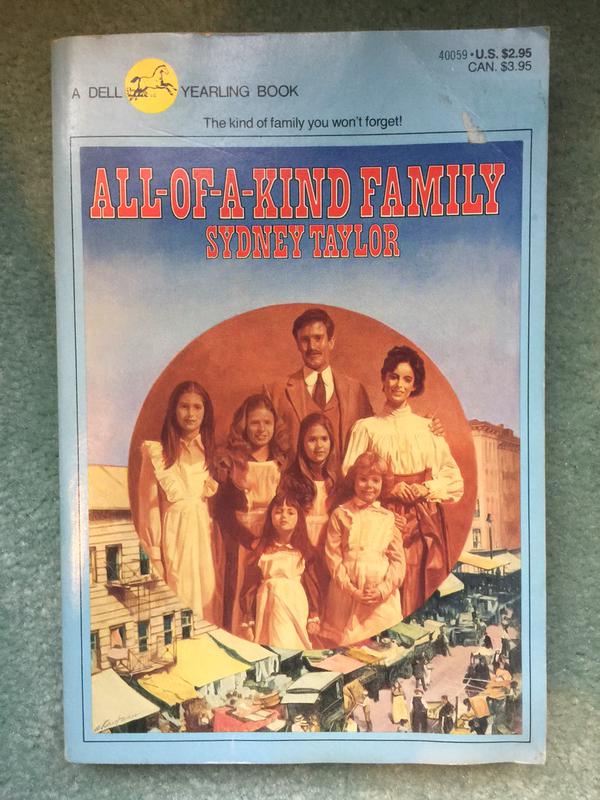
Still the best, so far as I’m concerned. Thanks, Sadie.


By:
Betsy Bird,
on 7/15/2014
Blog:
A Fuse #8 Production
(
Login to Add to MyJacketFlap)
JacketFlap tags:
Reviews,
nonfiction,
nonfiction picture books,
Best Books,
abrams,
Latino children's books,
Duncan Tonatiuh,
Latin American picture books,
Best Books of 2014,
Reviews 2014,
2014 reviews,
2014 nonfiction,
2015 Sibert Award contender,
Add a tag
 Separate is Never Equal: Sylvia Mendez and Her Family’s Fight for Desegretation
Separate is Never Equal: Sylvia Mendez and Her Family’s Fight for Desegretation
By Duncan Tonatiuh
Harry N. Abrams
$18.95
ISBN: 978-1419710544
Ages 7-12
On shelves now
If I blame my childhood education for anything I suppose it would be for instilling in me the belief that the history worth learning consisted of a set of universally understood facts. One event would be more worthy of coverage than another. One person better positioned for a biography than another. It was only in adulthood that I started to understand that the history we know is more a set of decisions made decades and decades ago by educators than anything else. Why were weeks and weeks of my childhood spent learning about The American Revolution but only a day on the Vietnam War? Why did we all read biographies of Thomas Edison but never about Nicolas Tesla? And why did it take me 36 years before someone mentioned the name of Sylvia Mendez to me? Here we have a girl with a story practically tailor made for a work of children’s nonfiction. Her tale has everything. Villains and heroes (her own heroic parents, no less). Huge historical significance (there’d be no Brown v. Board of Education without Sylvia). And it stars Latino-Americans. With the possible exception of Cesar Chavez, my education was pretty much lacking in any and all experience with Latino heroes in America. I’m therefore pleased as punch that we’ve something quite as amazing as Separate is Never Equal to fill in not just my gaps but the gaps of kids all over our nation.
Sylvia is going home in tears. Faced with teasing at her new school she tells her mother she doesn’t want to go back. Gently, her mother reminds her that teasing or no, this is exactly what the family fought so hard for for three long years. In 1944 the Mendez family had moved to Westminster, California. When the first day of school approached their Aunt drove five of the kids to the nearby public school. Yet when they arrived she was told that her children, with their light skin and brown hair could attend but that Sylvia and her brothers would have to go to “the Mexican school”. Faced with hugely inferior conditions, the Mendez family decides to fight back. They are inspired by a lawsuit to integrate the public pools and so they hire the same lawyer to take on their case. In court they hear firsthand the prejudices that the superintendent of their district holds dear, but ultimately they win. When that decision is appealed they take it to the state court, and win once more. Remembering all this, Sylvia returns to school where, in time, she makes friends from a variety of different backgrounds. Backmatter consists of an extensive Author’s Note, a Glossary, a Bibliography, additional information About the Text, and an Index.
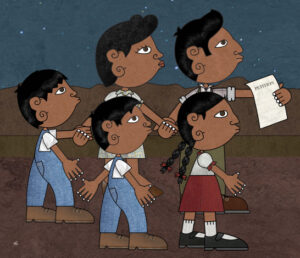 When I say that Sylvia’s story adapts perfectly to the nonfiction picture book form, I don’t want to downplay what Tonatiuh has done here. To tell Sylvia’s story accurately he didn’t have a single source to draw upon. Instead the book uses multiple sources, from court transcripts and films to books, websites, articles, and reports. Culling from all of this and then transferring it into something appropriate and interesting (that is key) for young readers is a worthy challenge. That Tonatiuh pulls it off is great, but I wonder if he could have done it if he hadn’t interviewed Sylvia Mendez herself in October 2012 and April 2013. Those who know me know that I’m a stickler for non-invented dialogue in my children’s works of nonfiction. If you can’t tell a real story without making up dialogue from real people then your book isn’t worth a lick. At first, it appears that Tonatiuh falls into the same trap, with Sylvia wondering some things and her family members saying other. Look at the backmatter, however, and you’ll see a note “About the Text”. It says that while the trial dialogue comes from court transcripts, the rest of the book came from conversations with Sylvia herself. So if she says her parents said one thing or she thought/pondered another, who are we to doubt her? Well played then.
When I say that Sylvia’s story adapts perfectly to the nonfiction picture book form, I don’t want to downplay what Tonatiuh has done here. To tell Sylvia’s story accurately he didn’t have a single source to draw upon. Instead the book uses multiple sources, from court transcripts and films to books, websites, articles, and reports. Culling from all of this and then transferring it into something appropriate and interesting (that is key) for young readers is a worthy challenge. That Tonatiuh pulls it off is great, but I wonder if he could have done it if he hadn’t interviewed Sylvia Mendez herself in October 2012 and April 2013. Those who know me know that I’m a stickler for non-invented dialogue in my children’s works of nonfiction. If you can’t tell a real story without making up dialogue from real people then your book isn’t worth a lick. At first, it appears that Tonatiuh falls into the same trap, with Sylvia wondering some things and her family members saying other. Look at the backmatter, however, and you’ll see a note “About the Text”. It says that while the trial dialogue comes from court transcripts, the rest of the book came from conversations with Sylvia herself. So if she says her parents said one thing or she thought/pondered another, who are we to doubt her? Well played then.
Librarians like myself spend so much time gushing over content and format that often we forget one essential element of any book: child-friendliness. It’s all well and good to put great information on picture book sized pages, but will any kid willingly read what you have? In this light, framing this book as a flashback was a clever move. Right from the start Tonatiuh places his story within the context of a child’s experience with mean kids. It’s a position a great many children can identify with, so immediately he’s established sympathy for the main character. She’s just like kids today . . . except a hero. At the end of the book we have photographs of the real participants, both then and now. As for the text itself, it’s very readable, keeping to the facts but, aided by the design and the art, eclectic enough to maintain interest.
 When we talk about Tonatiuh’s art it’s important to understand why he’s chosen the style that he has. In interviews the artist has discussed how his art is heavily influenced by ancient Mexican styles. As he said in an interview on the blog Seven Impossible Things Before Breakfast, “My artwork is very much inspired by Pre-Columbian art, especially by Mixtec codices from the 14th century. That is why my art is very geometric, my characters are always in profile, and their ears look a bit like the number three. My intention is to celebrate that ancient art and keep it alive.” Heads of participants are always shown from the side. This is combined with the decision to digitally insert real hair, of a variety of shades and hues and colors, onto the heads of the characters. The end result looks like nothing else out there. There are mild problems with it, since the neutral expression of the faces can resemble dislike or distaste. This comes up when Sylvia’s cousins are accepted into the nearest public school and she is not. Their faces are neutral but read the wrong way you might think they were coolly unimpressed with their darker skinned cousin. Still, once you’ve grown used to the style it’s hardly an impediment to enjoying the story.
When we talk about Tonatiuh’s art it’s important to understand why he’s chosen the style that he has. In interviews the artist has discussed how his art is heavily influenced by ancient Mexican styles. As he said in an interview on the blog Seven Impossible Things Before Breakfast, “My artwork is very much inspired by Pre-Columbian art, especially by Mixtec codices from the 14th century. That is why my art is very geometric, my characters are always in profile, and their ears look a bit like the number three. My intention is to celebrate that ancient art and keep it alive.” Heads of participants are always shown from the side. This is combined with the decision to digitally insert real hair, of a variety of shades and hues and colors, onto the heads of the characters. The end result looks like nothing else out there. There are mild problems with it, since the neutral expression of the faces can resemble dislike or distaste. This comes up when Sylvia’s cousins are accepted into the nearest public school and she is not. Their faces are neutral but read the wrong way you might think they were coolly unimpressed with their darker skinned cousin. Still, once you’ve grown used to the style it’s hardly an impediment to enjoying the story.
I think it’s important to stress for our children that when we talk about “integration”, we’re not just talking about African-American kids in the 1950s and 60s. Segregation includes Native Americans, Asian Americans, Latino Americans, and more. At one point in this book the Mendez family receives support from the NAACP, the Japanese American Citizens League, and the American Jewish Congress amongst others. Sylvia’s mother says, “When you fight for justice, others will follow”. For children to understand that freedom is never a done deal and that increased rights today means increased rights in the future is important. Books like Separate is Never Equal help drill the point home. There is absolutely nothing like this book on our shelves today. Pick it up when you want to hand a kid a book about Latino-American history that doesn’t involve Chavez for once. Required reading.
On shelves now.
Source: Final copy sent from publisher for review.
Like This? Then Try:


By:
Betsy Bird,
on 12/19/2013
Blog:
A Fuse #8 Production
(
Login to Add to MyJacketFlap)
JacketFlap tags:
Fusenews,
a cool cool robot,
P.L. Travers,
90 Second Newbery,
Children's Literary Salon,
Best Books of 2013,
evil baby gifts,
interactive book lists,
dolls,
NYPL,
bookshelves,
movie posters,
reading challenges,
Latino children's books,
Infographics,
Add a tag

- It’s been a good week and it’s only Thursday! I’ve cooed and oohed and aahed over NYPL’s 100 Titles for Reading and Sharing 2013 list before. Nothing new to say . . . or is there? I don’t suppose you happened to see NPR’s interactive booklist consisting of their Best Books of 2013 (in a rare moment of bliss, I like all their children’s book choices though some diversity wouldn’t have been out of place). Well, NYPL took one look at that list and thought, “Heck. We can do that.” And so they did! Meet the Interactive Books List of NYPL. It’s gorgeous. It’s user friendly. It’s the only place you can find animated Melissa Sweet. Overall, I rather love it. Hope you do too.
- In other best book news, Colby Sharp and Donalyn Miller teamed up at BuzzFeed and produced a list of 20 of the Best Children’s Books 2013. And AGAIN I like all the choices. Do you know how rare this is? Extra points for including Donner Dinner Party. Love that thing. Love anyone who includes it on a list.
- Having trouble keeping track of all the Best Of lists out there? Mr. Schu’s your man. Thanks to him, we now have a nicely compiled 2013 Best Books Lists posting. It’s very attractive. Of course, if you want the most complete listing out there, there’s no better place to go than Chicken Spaghetti. The information is AMAZING over there.
- A lot has been said lately about how big Best lists of children’s books this year have neglected to include any Latino characters (NPR and The New York Times most notably). Perfect timing then for the 2014 Reading Challenge suggested by Latin@s in Kid Lit. Take a look at the guidelines and join, but seriously? One book a month? I think you can handle that. They even have some suggestions to start you off (yay, Nino!).
- And, of course, if you read only one Best list, read the 100 Scope Notes highly hilarious Year in Miscellanea. Plus he mentions my superfluous little cupcake. Quoth he it’s, “the Axl Rose Hair Metal hair of picture book cover cupcakes.” You’re just going to have to read his piece to understand what that means.

- Tempted to see Saving Mr. Banks in the theater this holiday season? Feel free but be aware that the film may be throwing P.L. Travers under the bus in the process. A great piece from Jerry Griswold, former Director of the National Center for the Study of Children’s Literature.
- Anyone who has ever attended one of James Kennedy’s 90-Second Newbery Film Festivals will attest that they are a bundle of fun. Just the most delightful little films, created by kids, turning Newbery winners into concise 90-second films. Some are, understandably, better than others but there’s nothing cooler than sitting in a theater next to a kid who gets to see their film projected on a big screen for the first time in their young lives. Want to join in? The deadline for the next 90-second films is January 20th. So get cracking, young geniuses! For lots more information about the events and the showings, go here.
- Awww. This is so sweet. Over at Mocking It Up, Rebecca did me a solid and created this simply gorgeous infographic on the books that are topping the Mock Newbery lists around the country (she compiled results from 19 different Mocks). That’s a ton of work but the results are simply gorgeous. Wowzah! Well done, madam.
Why, yes. That IS a bookshelf in the shape of a robot.

Now you all know what you’re getting for your birthday. Surprise!


By:
Betsy Bird,
on 12/10/2013
Blog:
A Fuse #8 Production
(
Login to Add to MyJacketFlap)
JacketFlap tags:
Harry Potter,
Philip Pullman,
Book Art,
Charlie and the Chocolate Factory,
Jarrett Krosoczka,
James and the Giant Peach,
Latino children's books,
swimsuits,
Fusenews,
book jacket nattering,
The Witches,
Jim Kay,
gingerbread ain't for wimps,
Jane Yolen Mid-List Author Award,
Add a tag
 Don’t you hate it when you’ve saved oodles of links for a Fusenews only to find your computer apparently ate them without informing you? Fun times. So if I promised some of you that I’d post something and then I didn’t, remind me of the fact. Clearly me brain is running on fumes.
Don’t you hate it when you’ve saved oodles of links for a Fusenews only to find your computer apparently ate them without informing you? Fun times. So if I promised some of you that I’d post something and then I didn’t, remind me of the fact. Clearly me brain is running on fumes.
- Stop. Before you go any farther I will show you something that will make you laugh. It is this post by my sister on making a particularly unique gingerbread creation. If nothing else the photos at the end will make you snort in a distinctly unladylike manner.
- Please remind me the next time I wish to garner outrage to simply tap Philip Pullman. The man has sway. Big time sway.
The SCBWI is proud to announce the winner and honor recipients of the 2013 Jane Yolen Mid-List Author Award. Congratulations to winner Eve Feldman, author of such works asBilly and Milly Short and Silly (Putnam) and Dog Crazy (Tambourine). Eve has been a children’s book author and SCBWI member for over twenty years. To learn more about Eve visit www.evebfeldman.com.
Two Honor Grants were also awarded to authors Verla Kay and Deborah Lynn Jacobs. Verla Kay is the author of Civil War Drummer Boy (Putnam) and Hornbooks and Inkwells(Putnam) among others. Learn more at www.verlakay.com. Deborah Lynn Jacobs is the author of the young adult novels Choices (Roaring Brook Press) and Powers (Square Fish). Learn more at www.deborahlynnjacobs.com.
- Gift giving to a young ‘un when you yourself are without young ‘uns? Well, this post A Message to Those Without Children is dead on. She doesn’t mention alternatives but I can: What about books instead? Board books! Give it a whirl, prospective gift givers.

- The most amusing part of this Harry Potter Swimsuit Line to my mind isn’t the content so much as it is the models they got to wear the outfits. Most of them don’t seem to have any clue what they’re wearing. However, #2 in the Snape dress model appears to have been cast solely for the part and #3 has the decency to look slightly embarrassed to be there at all. Thanks to Liz Burns for the link.
- Speaking of HP, we all knew that the covers of the Harry Potter books were being re-illustrated here in the States. But how many of us knew that the Brits were planning on releasing full-color illustrated books with art by Jim Kay? Does the name Jim Kay ring a bell for you, by the way? You might be thinking of the art he did for A Monster Calls by Patrick Ness. That was a far cry from that cutesy Harry picture included in the article. Suddenly I can’t wait to see what the man can do with Dementors. Thanks to Ben Collinsworth for the link.
Doggone it. Yet again I delayed posting my Fusenews a day and failed to mention Jarrett Krosoczka’s Joe and Shirl Scholarship Auction in time. Sorry Jarrett! Fortunately, the man is no stranger to auctions of every stripe. This past Sunday there was a big fundraiser for First Book Manhattan at Symphony Space. The actors involved were HUGE and Jarrett was the lucky guy who got to host (he even played Glowworm to Paul Giamatti’s Centipede).
As part of the fun, Jarrett created this cool art. The Dahl estate then signed off on it to be auctioned off to continue to benefit First Book. Like what you see? Then buy here!
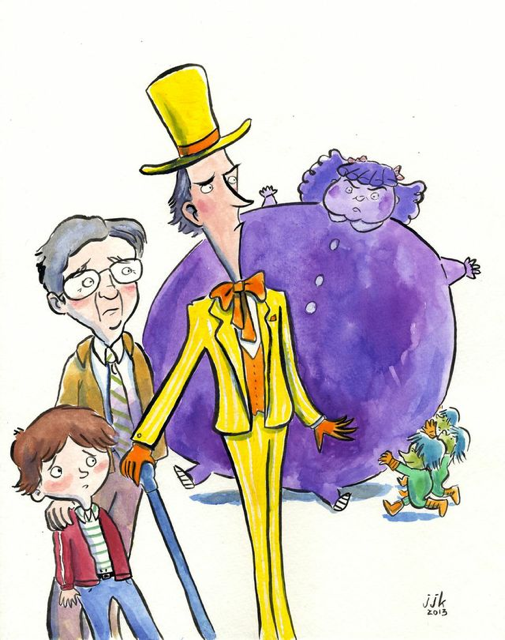
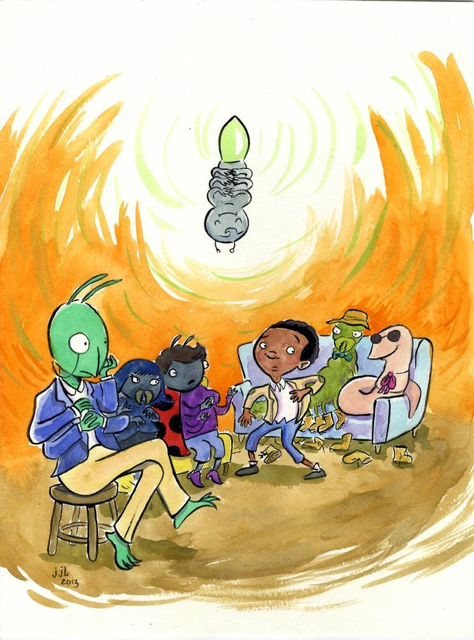
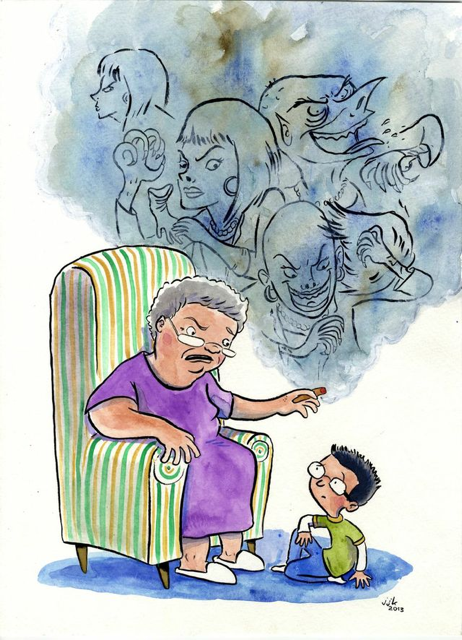
Bidding ends on Friday at 5 p.m.


By:
Betsy Bird,
on 12/7/2012
Blog:
A Fuse #8 Production
(
Login to Add to MyJacketFlap)
JacketFlap tags:
NYPL,
Best Books,
Latino children's books,
book jacket nattering,
Torrey Maldonado,
Jimmy Gownley,
Pinterest,
Common Core,
Hot Men of Children's Literature strike again,
Best Books of 2012,
Jane Curley,
Daphne Benedis-Grab,
Victorian children's books,
Uncategorized,
100 Titles for Reading and Sharing,
Add a tag
 The best books lists are abundant and here! So very exciting, yes? I do love this time of year, and so it makes sense to begin with the cream of the crop. I refer, of course, to NYPL’s 100 Titles for Reading and Sharing 2012. Split into seven different categories (Picture Books, Folk and Fairy Tales, Poetry and Song, Stories for Younger Readers, Stories for Older Readers, Graphic Books, and Nonfiction) the list has been around for precisely 101 years and is decided by the NYPL children’s librarians who go above and beyond the call of duty in reading EVERYTHING they can get their hands on. Seriously, those folks are the best. I tip my hat to them.
The best books lists are abundant and here! So very exciting, yes? I do love this time of year, and so it makes sense to begin with the cream of the crop. I refer, of course, to NYPL’s 100 Titles for Reading and Sharing 2012. Split into seven different categories (Picture Books, Folk and Fairy Tales, Poetry and Song, Stories for Younger Readers, Stories for Older Readers, Graphic Books, and Nonfiction) the list has been around for precisely 101 years and is decided by the NYPL children’s librarians who go above and beyond the call of duty in reading EVERYTHING they can get their hands on. Seriously, those folks are the best. I tip my hat to them.
- In other best books areas, over at Tablet we have the best kids books of 2012 containing Jewish themes and characters. How Marjorie Ingalls finds them all I do not know, but she is meticulous! I thought I’d seen everything but there were definitely a couple titles in there that flew under my radar (Sons of the 613, anyone?). Horn Book also came up with their Fanfare Books of 2012, and I was very very pleased to see Jimmy the Greatest on there. Woot! PW separated their top children’s books into the categories of Picture Books, Children’s Fiction (YA is sorta just crammed in there), and Nonfiction (only four titles?!?). Finally there was the Notable Children’s Books of 2012 list by the New York Times which has some truly eclectic ideas.
- By the way, if you want to see other best children’s book lists in this vein, there’s a Pinterest page of them up and running.
- In other Pinterest news (a sentence I can honestly say I’ve never written before), Nicole Deming of the CBC let me know about some cool children’s literature-related Pinterest lists they’ve created and that you might want to put on your radar. There’s Favorite Vintage Kids’ Books, Kids’ Book Creators, Kidlit Maps (maps from children’s books, old and new), and Kidlit Illustrators We ♥ . Thanks for the heads up, Nicole!
- I don’t usually do this but once in a while you meet a new or upcoming author who just catches your attention fully. I met a 6th grade schoolteacher in town the other day by the name of Torrey Maldonado. Torrey’s the author of the YA novel The Secret Saturdays. Knowing he worked in a public school I asked what he knew about Common Core. Quite a lot, it seems, since he created an entire page on his website dedicated to the Core and how to teach his book using it. To top it off, I’ve gotta say that I haven’t met an author with the sheer levels of enthusiasm and charm of Mr. Maldonado in a long time. Keep your eye on this fellow. I predict big things.
- Newsflash: Young Latinos don’t see themselves in books. Duh. Duh duh duh duh duh. It’s a really weird fact, and absolutely true. You go out there and find me an early chapter book series starring a Latino girl and I will give you a cookie. Go on. I’m waiting. I’ve got all day.
- Okay. Now I’m officially depressed. I was sorting through some books earlier today and I discovered the most recent “Amelia Rules” by Jimmy Gownley called Her Permanent Record. I own all of the Amelia Rules books except this one so I was pleased to down it during my lunch break. Then I went online just now to see when the next book in the series will be out . . . only to find that that was the LAST ONE. Hunhuna? Now that is depressing. I’ve deeply enjoyed this series for years and years now, and to think that it’s over fills me with a kind of strange dread. Gownley hasn’t entirely ruled out the possibility of more Amelias in the future . . . . but still, man. It’s kinda hard to take.
 The Dudes of YA, a “Lit-Erotic” Photo Spread. We would have also have accepted the term “The Hot Men of YA Literature”, but I suppose that would be copyright infringement or something, eh long-time readers who get my reference?
The Dudes of YA, a “Lit-Erotic” Photo Spread. We would have also have accepted the term “The Hot Men of YA Literature”, but I suppose that would be copyright infringement or something, eh long-time readers who get my reference?
- Look me in the eye. Now tell me this amazing new invention will not now appear in hundreds of middle grade spy/mystery novels. A pity you can’t get them in time for Christmas.
- Friend and YA author Daphne Benedis-Grab writes an excellent article over at She Knows about raising a girl in a day and age where beauty standards have never been more impossible to attain. It’s called Raising a girl to be more than a pretty face. Testify!
- PW Children’s Bookshelf linked to some pretty thought provoking articles this week. My favorite: Leonard Marcus at Horn Book talking about book jackets . . . for picture books!
- In other news, PW did a very strange bit of reporting. It mentioned the recent 90-Second Newbery at Symphony Space, which was a packed house and a big success. However, there is a VERY odd lack of any mention about the organizer, YA author James Kennedy. Read the piece and you’ll have the distinct impression that it happened spontaneously and without his back-breaking work. Reporting fail, PW my dear.
- I got the following message from Jane Curley of the Eric Carle Museum and I am passing it on because it sound bloody blooming amazing: “I’m giving a talk for the Victorian Society on 19th century British picture books. It’s on Tuesday, December 11 at 6PM at the Dominican Academy, 44 East 68th St.It’s free, no reservations required, and I’ll be showing some gorgeous pictures! The link is below. Cheers, Jane http://metrovsa.org/calendar.htm“.
I ran about the internet trying to find the perfect thing for today’s post but in the end I had to come back to the washable keyboard. The perfect gift for your favorite hypochondriac this holiday season.

Thanks due to AL Direct for the link.

By:
Aline Pereira,
on 9/13/2011
Blog:
PaperTigers
(
Login to Add to MyJacketFlap)
JacketFlap tags:
Cultures and Countries,
latino authors and illustrators,
Extreme Yum: The Zing of Sharing Bookjoy & Growing Día,
National Association to Promote Library and Information Services to Latinos and Spanish Speaking,
Pat Mora,
Eventful World,
Hispanic,
El Dia de los Ninos,
El Dia de los Libros,
children's book day,
Hispanic Heritage Month,
REFORMA,
hispanic children's books,
latino children's books,
Hispanic culture,
Add a tag
 REFORMA, the National Association to Promote Library and Information Services to Latinos and Spanish Speaking, is celebrating it’s 40th anniversary and will be holding it’s 4th National Conference this week. The four day conference starts Sept 15 (which coincides with the start off National Hispanic Heritage Month) at the Westin Hotel in Denver, CO, USA and is expected to draw over 500 participants. The theme for the conference is “Elevating Latino Services to a Higher Level: Juntos in the Mile High City!” and a plethora of events have been scheduled including seminars, author readings, continuing education workshops, enlightening panel discussions, and vendor exhibits.
REFORMA, the National Association to Promote Library and Information Services to Latinos and Spanish Speaking, is celebrating it’s 40th anniversary and will be holding it’s 4th National Conference this week. The four day conference starts Sept 15 (which coincides with the start off National Hispanic Heritage Month) at the Westin Hotel in Denver, CO, USA and is expected to draw over 500 participants. The theme for the conference is “Elevating Latino Services to a Higher Level: Juntos in the Mile High City!” and a plethora of events have been scheduled including seminars, author readings, continuing education workshops, enlightening panel discussions, and vendor exhibits.
If you are in the Denver area and interested in attending, you should know that you don’t have to be a member of REFORMA to attend. Non-members can still register and are welcome to come participate as well as purchase exhibit only passes. Click here to download the schedule and see what might appeal to you.
Among the many great events planned is an author luncheon with award winning author and literacy advocate Pat Mora on Sept 16 from 12:30 – 2:00 pm
Extreme Yum: The Zing of Sharing Bookjoy & Growing Día
A former teacher, university administrator, consultant, and the author of many award winning children’s books, Pat is the also the founder of the family literary initiative El día de los niños / El día de los libros, Children’s Day / Book Day (Día), now an initiative of at the American Library Association. The year-long commitment to linking all children to books, languages and cultures, and of sharing what Ms. Mora calls “Bookjoy,” culminates in Día events across the country. Día celebrated its 15th Anniversary in April 2011.
To learn more about Pat Mora read our interview with her here.
PaperTigers’ September 2007 and September 2008 issues focused on National Hispanic Heritage Month and include interviews, articles, books and artwork that capture the Hispanic temper of our times.

By:
Aline Pereira,
on 5/15/2011
Blog:
PaperTigers
(
Login to Add to MyJacketFlap)
JacketFlap tags:
latino authors and illustrators,
Latino writers conference,
Eventful World,
Monica Brown,
National Hispanic Cultural Center,
Latin America,
National Latino Writers Conference,
Francisco X. Alarcón,
latino children's books,
Cultures and Countries,
Add a tag
The 9th annual National Latino Writers Conference takes place May 19 – 21 at the National Hispanic Cultural Center in Albuquerque, New Mexico, USA. The conference is uniquely devoted to writing by and for Latinos and is a magnet for Latino writers whose work has often been neglected by major publishing houses. Nationally prominent authors, editors and agents will come together to present workshops, panels and participate in one-on-one consultations with participants. Children’s book author Monica Brown will teach two workshops on Writing for Children and Francisco Alarcón will be teaching El Poder de la Poesía: Poetry for Two Languages. While all workshops and panels are closed to the public, the May 19th poetry reading by Alurista in the Bank of America Theatre will be open and free to the public.
For more information and to register click here.

By:
Aline Pereira,
on 9/13/2010
Blog:
PaperTigers
(
Login to Add to MyJacketFlap)
JacketFlap tags:
Eventful World,
Latin America,
Edward James Olmos,
Latino Book and Family Festival,
Latino Book Awards,
Latino Literacy Now,
latino children's books,
multicultural children's literature event,
Latino Books in to Movies Award,
Add a tag

The countdown has begun for this year’s Los Angeles Latino Book & Family Festival which will be held October 9th and 10th at California State University. Over 120 Latino authors and artists will be in attendance and nearly 50 panels, readings, and workshops will be offered throughout the weekend. In addition there will be books signings, storytelling, folklorico dances, music and much more. The event is free and all are welcome to attend.
Non-profit organization Latino Literacy Now! launched the Latino Book & Family Festival in 1997 in Los Angeles to promote literacy, culture and education and to provide people of all ages and backgrounds with the opportunity to celebrate the diversity of the multicultural communities in the United States in a festival atmosphere. Today, the Latino Book & Family Festival is hosted in several major Latino markets across the U.S. including Houston, Chicago and Los Angeles. Well known actor and community activist Edward James Olmos is the co-producer of the festival.
A special fundraiser for this year’s event, “An Evening with the Authors” takes place on October 9 and gives guests the chance to dine with their favorite authors! During the evening the winners of the 2010 International Latino Book Awards will be honored and the 1st annual Latino Books in to Movies Awards will be presented. To purchase tickets to the dinner click here.
Latino Literacy Now has also joined with Pan American Bank (located at 3626 East First Street, Los Angeles) to host a nine week-long children’s program that will feature prominent Latino children’s book authors. The reading program called The Children’s Reading Hour, will take place at 12pm on Saturdays from Sept 11 – Nov 6. The first 10 children to show up each Saturday will receive an autographed book. Click here to see the schedule of authors.
“We are thrilled that the authors will join us in supporting our community’s youth. Reading to children is the best way to encourage literacy and life-long learning. It is also an incredible way to teach important lessons,” said Pan American Bank CEO Jesse Torres. “These Latino authors are not only incredible Latino writers – they are incredible authors, period!”

By:
Aline Pereira,
on 5/22/2010
Blog:
PaperTigers
(
Login to Add to MyJacketFlap)
JacketFlap tags:
Eventful World,
Latin America,
Latino Book and Family Festival,
Latino Book Awards,
Latino Literacy Now,
latino children's books,
multicultural children's literature event,
Cultures and Countries,
Mexican American,
Add a tag
 Preparations for the Los Angeles Latino Book & Family Festival are underway. An outstanding lineup of authors and panels is being put together, as well as performers, and special appearances by celebrities and representatives of the Latino community. To be held at California State University Los Angeles (CSULA), the festival will feature a main stage, a children’s area and stage, and three lecture halls/classrooms for author presentations. More information, including a list of confirmed authors, is available here and to make sure you receive regular updates, sign up for their newsletter here.
Preparations for the Los Angeles Latino Book & Family Festival are underway. An outstanding lineup of authors and panels is being put together, as well as performers, and special appearances by celebrities and representatives of the Latino community. To be held at California State University Los Angeles (CSULA), the festival will feature a main stage, a children’s area and stage, and three lecture halls/classrooms for author presentations. More information, including a list of confirmed authors, is available here and to make sure you receive regular updates, sign up for their newsletter here.
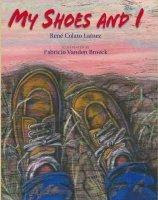 Writing from My Immigrant Experience
Writing from My Immigrant Experience
by René Colato Laínez
When immigrant children come to the United States, they experience a variety of emotional and cognitive adjustments in the new country. They have left behind a language, a culture and a community. From one moment to another, their familiar world changes into an unknown world of uncertainties. These children have been uprooted from all signs of the familiar and have been transported to an unfamiliar foreign land. In the process of adaptation, immigrant children experience some degree of shock. IN THE INNER WORLD OF THE IMMIGRANT CHILD, Cristina Igoa writes:
"This culture shock is much the same as the shock we observe in a plant when a gardener transplants it from one soil to another. We know that shock occurs in plants, but we are not always conscious of the effects of such transplants on children. Some plants survive, often because of the gardener’s care; some children survive because of the teachers, peers, or a significant person who nurtures them during the transition into a new social milieu."
I use my experience of being uprooted from my country of origin, being transplanted to the United States and my adaptation to a new culture in order to authentically and realistically portray the immigrant experience my picture books such as WAITING FOR PAPÁ, I AM RENÉ, THE BOY, RENÉ HAS TWO LAST NAMES and my new book MY SHOES AND I.
Stages of Uprooting
Immigrant children go through stages of uprooting to adapt to a new country:
1-Mixed emotions
2-Excitement or fear in the adventure of the journey
3-Curiosity, culture shock that exhibits as depression or confusion
4- Assimilation/ acculturation into the mainstream
During the first stage of the uprooting, children experience mixed emotions when the parents tell them that they will be moving to another country. Sometimes they are not informed until the actual day their journey begins. Most of the time the children do not know where they are going. They only know they must go because their parents are going. They do not have a choice.
In the second stage the children experience excitement or fear during the journey by train, car, plane, boat or on foot. They are usually with a parent or relative, and there is much discussion among them in their own language. The long and tiring journey begins.
MY SHOES AND I takes place during the first and second stages of uprooting. Mario is informed by his father that they are moving to the united states to meet Mamá.
For Christmas, Mamá sent me a new pair of shoes from the United States.
I love my new shoes. They walk everywhere I walk. They jump every time I jump. They run as fast as me. We always cross the finish line at the same time.
“Mario, these are very good shoes for the trip,” Papá says.
Papá tells me that it is a very long trip. We need to cross three countries. But no matter how long the trip will be, I will get there. My shoes will take me anywhere.
In MY SHOES AND I, I am telling my story and the stories of thousands of children who need to cross borders in order to accomplish their dreams.
About the book:
Mario is leaving his home in El Salvador. With his father by his side, he is going north to join his mother, who lives in the United States. She has sent Mario a new pair of shoes, and he is thrilled. He will need goo

It is my pleasure to introduce you to award-winning children's author, storyteller and librarian Lucia Gonzalez. Her classic Cuban folk tale, The Bossy Gallito, was awarded the Pura Belpre Children's Literature Honor Medal by the American Library Association, and selected for New York's Top 20 All Time Favorite Children's Books by the New York Times "Great Children's Read." Her second book, Senor Cat's Romance, a collection of popular folk tales from Latin America, also received immediate recognition. Her latest children's book, The Storyteller's Candle, is dedicated to Pura Belpre, New York City's first Latina librarian.
Thanks for being my guest today, Lucia. Tell us, when did you begin writing for children?
First, I was a storyteller and children’s librarian. As part of my job in the library I told many of the stories that were told to me while I was growing up in Cuba but that I could not find in books. While telling those stories I wrote some of them and sent them to Scholastic. They loved them and published my first two stories in an anthology, From Sea to Shining Sea: A Treasury of American Folklore and Folksongs, edited by Amy Cohn. This was in 1993.
Which one of your books was published first? Would you share with us how the publishing process was?
For me the publishing process has been a great gift from life. Among the stories I submitted to Scholastic in 1993, was one about a bossy little rooster on the way to the wedding of his uncle the parrot. The editor loved that story so much that she asked me if I wouldn't mind publishing it as a stand-alone picture book, illustrated by Lulu Delacre. Imagine my surprise. I wrote the story in Spanish and English, keeping the rhythm and internal music of the Spanish version in the English retelling. The book became The Bossy Gallito, published in 1994 by Scholastic.
Tell us about your latest book,The Storyteller's Candle, which, as I understand it, is a homeage to Pura Belpre, New York City's first Latina librarian. What compelled you to based one of your stories on her?
Yes, I wrote The Storyteller’s Candle/La velita de los cuentos dedicated to the memory of Pura Belpré, a devoted and talented librarian, author, and storyteller who was also a community activist and a visionary pioneer in providing library outreach services to immigrant families and who understood the importance of honoring the immigrants' languages and preserving their stories. I was also inspired by New York Public Library's storytelling tradition.
Would you describe your creative process when writing a children's picture book?
As a storyteller, I tell before I write. The audience is my first editor. I follow my instincts and my firm conviction that the books I write are needed. I do a lot of research, immersing my self in the culture, or the subject of the story so that I can capture its spirit and I can write a story that is faithful to it.
What makes an excellent picture book?
The most important elements are honest language and authentic voice in telling the story.
Wearing your librarian's hat, would you tell us what type of children's stories are the most popular with kids right now? Has the children's book market changed a lot during the last decade?
Children like series. They like the continuity of series. The Harry Potter books had a lot to

Dia del Niño / Dia del Libro
Children's Day/Book Day
When:
Saturday April 25 12:00pm - 2:00pm
Where:
East Harlem Cafe
1651 Lexington Ave (@ 104th St.)
El Barrio, NY 10029
Volunteers needed for this event to help with kids' activity table. Email [email protected].
FREE EVENT! BRING THE KIDS!
"'Dia del Niño/Dia de Libro' emphasizes the importance of advocating literacy for children of all linguistic and cultural backgrounds. Its goals are to honor children, languages and cultures; to encourage reading and literacy; and to promote library collections and programs that reflect our plurality. This local party promotes reading and bilingualism to children of all backgrounds."
 Children's authors Lissette Norman and Annette Perez will be reading and signing books. There will be face painting and craft for kids. Don't miss your chance to have your kids meet these authors. Children love to meet real-life authors and asks for autographs.
Children's authors Lissette Norman and Annette Perez will be reading and signing books. There will be face painting and craft for kids. Don't miss your chance to have your kids meet these authors. Children love to meet real-life authors and asks for autographs.
About Lissette Norman: Lissette Norman is an award-winning poet with many published credits to her name. She lives in New York City. My Feet Are Laughing is her first children's book.
Book's blurb: Sadie likes living in her grandmother’s brownstone, where she has her own bedroom and a backyard to play in. She’s full of thoughts and has lots to say about her family and friends, her home, her hair, and her laughing feet that can’t keep still. And when she grows up she plans on being a poet.
This collection of sixteen exuberant poems in the voice of a young Dominican American girl and energetic, bright paintings celebrates Sadie’s family and the city around her.
About Annette Perez: Annette Perez was born in New York City to a family of Puerto Rican origin. Annette was diagnosed with hydrocephalus as an infant. Growing up with this disability was not easy. Her childhood was filled with consta nt challenges, including learning how to tie her shoelaces one-handed. However, she considers herself among the lucky ones since she can function and live a normal life. Annette graduated from Borough of Manhattan Community College (City University of New York) with an Associate's Degree in Early Childhood Education, and obtained a Bachelor's Degree in Spanish from York College. She is currently pursuing her Master's Degree in Early Childhood Education and Special Education (obviously, her brain did not float away!) She lives in Queens, New York. This is her first book, lovingly dedicated to her parents.
nt challenges, including learning how to tie her shoelaces one-handed. However, she considers herself among the lucky ones since she can function and live a normal life. Annette graduated from Borough of Manhattan Community College (City University of New York) with an Associate's Degree in Early Childhood Education, and obtained a Bachelor's Degree in Spanish from York College. She is currently pursuing her Master's Degree in Early Childhood Education and Special Education (obviously, her brain did not float away!) She lives in Queens, New York. This is her first book, lovingly dedicated to her parents.
Book's blurb: Annie, an eight-year-old girl, gathers the courage to ask her mother, "Why is one of my hands smaller than the other? Why do I fall so much?" What follows is a story of fears, will, self discovery, and finally, triumph. Annette Perez narrates her true story of growing up with hydrocephalus with humor, honesty, and compassion, and proves with this story that even the simplest act can change one's life forever.

By:
Aline Pereira,
on 10/3/2008
Blog:
PaperTigers
(
Login to Add to MyJacketFlap)
JacketFlap tags:
Authors,
Yuyi Morales,
Pat Mora,
Eventful World,
Illustrators,
Laura Resau,
Latino Book Awards,
Rafael Lopez,
Hispanic Heritage Month,
Jorge Argueta,
2008 Américas Award,
Carmen T. Bernier,
hispanic children's books,
latino children's books,
multicultural children's literature,
Children's Books,
Add a tag
 If you’ve had a chance to savor Yum! Mmm! Que Rico! America’s Sproutings, or any of the books in this year’s Américas Award list of winners, honor books and commended titles, you will understand how spot-on this award’s committee is in recognizing and honoring accurate portrayals of our Americas’ rich cultural heritage.
If you’ve had a chance to savor Yum! Mmm! Que Rico! America’s Sproutings, or any of the books in this year’s Américas Award list of winners, honor books and commended titles, you will understand how spot-on this award’s committee is in recognizing and honoring accurate portrayals of our Americas’ rich cultural heritage.
As this year’s winners, Pat Mora and Rafael Lopez’s Yum! Mmm! Que Rico! and Laura Resau’s Red Glass will be honored tomorrow (Oct 4), at a ceremony at the Library of Congress, in Washington D.C. Hosted by the Library of Congress’s Hispanic Division and the Center for the Book, the event is free and open to the public, so don’t miss it if you are in the area!
Yuyi Morales’ Little Night, Jorge Argueta’s Alfredito Flies Home and Carmen T. Bernier’s Frida: Viva la Vida! are among the honored and commended titles selected by the award’s 2008 committee.
What better way to celebrate Hispanic Heritage Month than by giving these books the recognition and readership they deserve?
 Juana and Lucas
Juana and Lucas You might think that Juana has it pretty good, and for the most part you’d be right. She lives in Bogota, Colombia “the city that’s closest to my heart” with her Mami. She has a good furry best friend (her dog, Lucas) and a good not-so-furry best friend (Juli). And hey, it’s the first day of school! Cool, right? Only nothing goes the way Juana planned. The whole unfortunate day is capped off when one of her teachers informs the class that they will be learning “the English” this year. Could anything be more unfair? Yet as Juana searches for sympathy amongst her friends and relatives, she realizes that everyone seems to think that learning English is a good thing. Are they crazy? It isn’t until an opportunity comes up to visit somewhere fantastic, far away, and English speaking that she finally takes what everyone has told her to heart. In a big way.
You might think that Juana has it pretty good, and for the most part you’d be right. She lives in Bogota, Colombia “the city that’s closest to my heart” with her Mami. She has a good furry best friend (her dog, Lucas) and a good not-so-furry best friend (Juli). And hey, it’s the first day of school! Cool, right? Only nothing goes the way Juana planned. The whole unfortunate day is capped off when one of her teachers informs the class that they will be learning “the English” this year. Could anything be more unfair? Yet as Juana searches for sympathy amongst her friends and relatives, she realizes that everyone seems to think that learning English is a good thing. Are they crazy? It isn’t until an opportunity comes up to visit somewhere fantastic, far away, and English speaking that she finally takes what everyone has told her to heart. In a big way. Early chapter books are interesting because publishers see them as far more series-driven than their writers might. An author can crank out title after title after title to feed the needs of their young readers, always assuming the demand is there, and they can do it easier with books under 100 pages than above. Juana could fit the bill in this regard. Her personality is likable, for starters. She’s not rude like Junie B. Jones or willfully headstrong in the same way as Ramona, but she does screw up. She does complain wildly. There are aspects of her personality you can identify with right from the start. I’d be pleased to see more of her in the future, and young readers will undoubtedly feel the same way. Plus, she has one particular feature that puts her heads and tails above a lot of the competition: She’s in color.
Early chapter books are interesting because publishers see them as far more series-driven than their writers might. An author can crank out title after title after title to feed the needs of their young readers, always assuming the demand is there, and they can do it easier with books under 100 pages than above. Juana could fit the bill in this regard. Her personality is likable, for starters. She’s not rude like Junie B. Jones or willfully headstrong in the same way as Ramona, but she does screw up. She does complain wildly. There are aspects of her personality you can identify with right from the start. I’d be pleased to see more of her in the future, and young readers will undoubtedly feel the same way. Plus, she has one particular feature that puts her heads and tails above a lot of the competition: She’s in color. The writing is good, though the conclusion struck me as a bit rushed. Admittedly the solution to Juana’s problems is tied up pretty quickly. She won’t learn, she won’t learn, she won’t learn. She gets to have a prize? She studies and studies and studies. So rather than have her come to an understanding of English’s use on her own, an outside force (in this case, the promise of seeing Astroman) is the true impetus to her change. Sure, at the very end of the book she suddenly hits on the importance of learning other languages and visiting other places around the globe but it’s a bit after the fact. Not a big problem in the book, of course, but it would have been cool to have Juana come to this realization without outside influences.
The writing is good, though the conclusion struck me as a bit rushed. Admittedly the solution to Juana’s problems is tied up pretty quickly. She won’t learn, she won’t learn, she won’t learn. She gets to have a prize? She studies and studies and studies. So rather than have her come to an understanding of English’s use on her own, an outside force (in this case, the promise of seeing Astroman) is the true impetus to her change. Sure, at the very end of the book she suddenly hits on the importance of learning other languages and visiting other places around the globe but it’s a bit after the fact. Not a big problem in the book, of course, but it would have been cool to have Juana come to this realization without outside influences.













































 REFORMA, the National Association to Promote Library and Information Services to Latinos and Spanish Speaking
REFORMA, the National Association to Promote Library and Information Services to Latinos and Spanish Speaking
 Preparations for the Los Angeles
Preparations for the Los Angeles 


 Children's authors
Children's authors nt challenges, including learning how to tie her shoelaces one-handed. However, she considers herself among the lucky ones since she can function and live a normal life. Annette graduated from Borough of Manhattan Community College (City University of New York) with an Associate's Degree in Early Childhood Education, and obtained a Bachelor's Degree in Spanish from York College. She is currently pursuing her Master's Degree in Early Childhood Education and Special Education (obviously, her brain did not float away!) She lives in Queens, New York. This is her first book, lovingly dedicated to her parents.
nt challenges, including learning how to tie her shoelaces one-handed. However, she considers herself among the lucky ones since she can function and live a normal life. Annette graduated from Borough of Manhattan Community College (City University of New York) with an Associate's Degree in Early Childhood Education, and obtained a Bachelor's Degree in Spanish from York College. She is currently pursuing her Master's Degree in Early Childhood Education and Special Education (obviously, her brain did not float away!) She lives in Queens, New York. This is her first book, lovingly dedicated to her parents.


 Author
Author
I think you mixed up Alma Flora Ada’s ISLAND TREASURES with Margarita Engle’s ENCHANTED AIR.
Aw pfui. Good call. Good early-morning-I-can-totally-change-this call. Much obliged.
Well said.
I loved PORTRAITS OF HISPANIC AMERICAN HEROES and TWAS NOCHEBUENA!
I wouldn’t call Enchanted Air any more YA than Stead’s Goodbye Stranger. 12 and up sez the publisher and I’d agree.
Haven’t read it myself, so I was just going by the publisher descriptions. I’ll wait and see how the reviews look.
They’re great, but they’re 2014 titles. I’m just counting 2015 today. But good thinking!
Here are some others: http://latinosinkidlit.com/2015/01/22/more-libros-latinos-18-ya-mg-novels-by-about-latinos-in-2015/
The interesting thing about that links is the sheer number of YA titles vs. children’s book titles. I wonder if there’s a significant difference in the market itself. After all, when it comes to sheer numbers there are more children’s books than YA titles published in a given year. Food for thought.
AHH! I LOVE this list! Thanks, Betsy! I really enjoyed ROLLER GIRL and UNUSUAL CHICKENS FOR THE EXCEPTIONAL POULTRY FARMER. Both so great at just casually weaving the character’s culture into the fantastic storylines. Looking forward to more great reading this year. This Latina’s gonna buy some books.